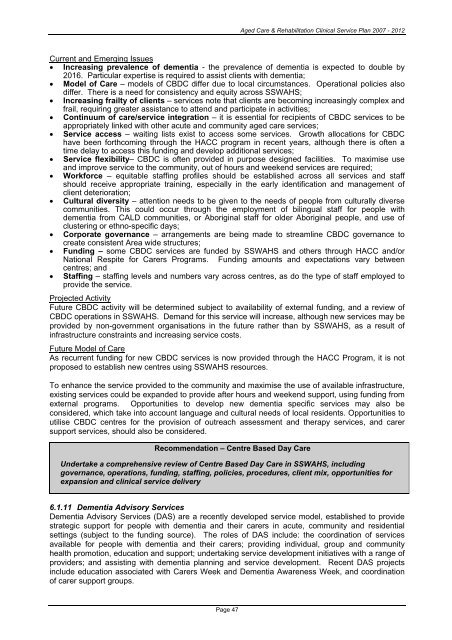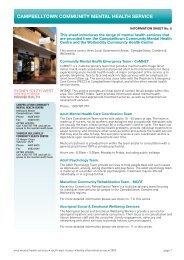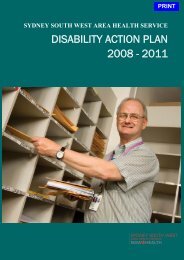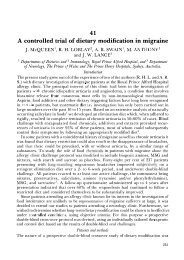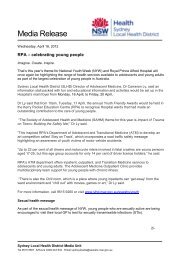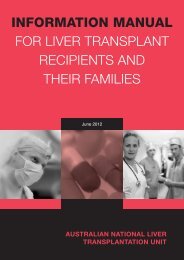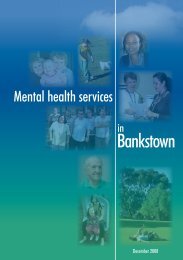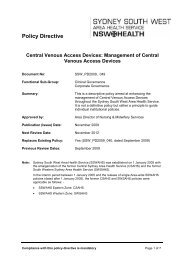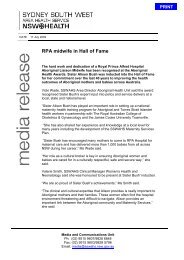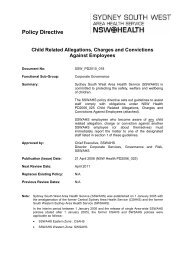Aged Care & Rehabilitation Clinical Services Plan 2007 – 2012
Aged Care & Rehabilitation Clinical Services Plan 2007 – 2012
Aged Care & Rehabilitation Clinical Services Plan 2007 – 2012
You also want an ePaper? Increase the reach of your titles
YUMPU automatically turns print PDFs into web optimized ePapers that Google loves.
<strong>Aged</strong> <strong>Care</strong> & <strong>Rehabilitation</strong> <strong>Clinical</strong> Service <strong>Plan</strong> <strong>2007</strong> - <strong>2012</strong>Current and Emerging Issues• Increasing prevalence of dementia - the prevalence of dementia is expected to double by2016. Particular expertise is required to assist clients with dementia;• Model of <strong>Care</strong> – models of CBDC differ due to local circumstances. Operational policies alsodiffer. There is a need for consistency and equity across SSWAHS;• Increasing frailty of clients – services note that clients are becoming increasingly complex andfrail, requiring greater assistance to attend and participate in activities;• Continuum of care/service integration – it is essential for recipients of CBDC services to beappropriately linked with other acute and community aged care services;• Service access – waiting lists exist to access some services. Growth allocations for CBDChave been forthcoming through the HACC program in recent years, although there is often atime delay to access this funding and develop additional services;• Service flexibility– CBDC is often provided in purpose designed facilities. To maximise useand improve service to the community, out of hours and weekend services are required;• Workforce – equitable staffing profiles should be established across all services and staffshould receive appropriate training, especially in the early identification and management ofclient deterioration;• Cultural diversity – attention needs to be given to the needs of people from culturally diversecommunities. This could occur through the employment of bilingual staff for people withdementia from CALD communities, or Aboriginal staff for older Aboriginal people, and use ofclustering or ethno-specific days;• Corporate governance – arrangements are being made to streamline CBDC governance tocreate consistent Area wide structures;• Funding – some CBDC services are funded by SSWAHS and others through HACC and/orNational Respite for <strong>Care</strong>rs Programs. Funding amounts and expectations vary betweencentres; and• Staffing – staffing levels and numbers vary across centres, as do the type of staff employed toprovide the service.Projected ActivityFuture CBDC activity will be determined subject to availability of external funding, and a review ofCBDC operations in SSWAHS. Demand for this service will increase, although new services may beprovided by non-government organisations in the future rather than by SSWAHS, as a result ofinfrastructure constraints and increasing service costs.Future Model of <strong>Care</strong>As recurrent funding for new CBDC services is now provided through the HACC Program, it is notproposed to establish new centres using SSWAHS resources.To enhance the service provided to the community and maximise the use of available infrastructure,existing services could be expanded to provide after hours and weekend support, using funding fromexternal programs. Opportunities to develop new dementia specific services may also beconsidered, which take into account language and cultural needs of local residents. Opportunities toutilise CBDC centres for the provision of outreach assessment and therapy services, and carersupport services, should also be considered.Recommendation – Centre Based Day <strong>Care</strong>Undertake a comprehensive review of Centre Based Day <strong>Care</strong> in SSWAHS, includinggovernance, operations, funding, staffing, policies, procedures, client mix, opportunities forexpansion and clinical service delivery6.1.11 Dementia Advisory <strong>Services</strong>Dementia Advisory <strong>Services</strong> (DAS) are a recently developed service model, established to providestrategic support for people with dementia and their carers in acute, community and residentialsettings (subject to the funding source). The roles of DAS include: the coordination of servicesavailable for people with dementia and their carers; providing individual, group and communityhealth promotion, education and support; undertaking service development initiatives with a range ofproviders; and assisting with dementia planning and service development. Recent DAS projectsinclude education associated with <strong>Care</strong>rs Week and Dementia Awareness Week, and coordinationof carer support groups.Page 47


